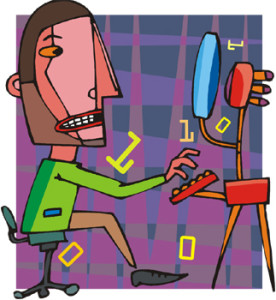This post appeared in my Huffington Post column on January 16, 2013.
In the afterglow of the 2014 Consumer Electronics Show (CES), away from the neon lights of Las Vegas, 4D curved TV screens, and uber-hip Google Glass wearers, a big question remains: Do we, the people, really want to tech our way to self-health?
The number of digital health companies exhibiting at CES grew by 40 percent, exceeding 300 based on the count of the International Consumer Electronics Association, sponsor of the event.
The hockey-stick growth of “wearable technology” seen at the 2014 Consumer Electronics Show begs the question: Are there enough consumers on the demand-side who want to keep track of themselves to take up the supply side of this market? Will people pay out-of-pocket for gadgets that help them measure their steps, track their sleep, quantify their calories, record their heart rate, and feedback their mood?
There is currently low-adoption of digital health devices among U.S. adults. The latest data from Altarum’s Fall 2013 Consumer Survey show that:
• Only 1 in 5 patients has ever obtained personal health data online for the purpose of sharing this information with family or physicians.
• Only 17 percent of people have ever sent an online message to their doctor.
• Only 16 percent of people have taken steps to store their health information online, like at WebMD or via Microsoft HealthVault.
• Only 6 percent of people wear a digital health tracking device.
• 1 in 10 people use a mobile health app.
Altarum’s report says: A flurry of new technologies is designed to help patients keep track of information — such as medical conditions, appointments, test results, and medications — and measure progress toward health-related goals.
At the 2014 CES, I saw this “flurry” in person, dozens of health activity trackers along with a growing number of medically-oriented devices to measure heart rate, blood glucose, lung function, and other more clinical metrics beyond steps and calorie intake.
In the post-CES real world, back on terra firma in middle America where one gains perspective away from the madding crowd of 160,000 techno-optimists, I ponder the question of just how many of us really and truly seek to know, on a daily basis, our bodies, our selves.
Several other analyst peers of mine are asking this question in various ways. First, the issue of privacy has been raised: Do we want to generate personal health information if we’re worried about NSA hacking and privacy issues? Target Corporation’s breach of 110 million consumers’ credit card records during the 2013 Christmas season did nothing to nurture peoples’ confidence in digital information — let alone digital health information.
One interesting example concerning the privacy and security of growing amounts of personal health data generated by sensors was cited by a chief technology officer of a security company, quoted as saying, “Samsung may try to collect data on the contents of my refrigerator to send me advertisements.”
Second, few wearables balance fashion and function, opined another writer. I have to agree: The proliferation of bulky black smartwatches and arm cuffs don’t work well into a fashionista’s wardrobe, or even a busy person’s lifestyle. Cumbersome design isn’t acceptable anymore when consumers have learned to appreciate more streamlined approaches to consumer products that Apple, Ikea and Target (e.g., their prize-winning medicine bottle) make manifest in today’s marketplace.
Still, ever the optimist, the head of the Consumer Electronics Association, Gary Shapiro, reminded us to look at the first iPod. “It was bulky and it wasn’t that pretty. Look what happened. It got slimmer. It got better.”
The proliferation of hard black metal smartwatches was punctuated by colorful news of alliances between: Tory Burch and Fitbit; Barneys, the Council of Fashion Designers of America, and Intel; and Cellini, the jeweler, with CSR’s Bluetooth-enabled “smart jewelry,” among other partnerships looking to mash up fashion with function.
But it will take more than bling to motivate the vast middle market to take on the role of health-tracking citizen. Caveat emptor to investors seeing short-term dollar signs in the digital health sector. Don’t get blindsided by the supply side of the market, even as you don your Google Glasses. The demand side of consumers, largely still confined to the couch, will need convincing through a variety of strong nudges, including but not limited to “carrots” (in the form or reduced premiums for health insurance and free stuff), “sticks” (through increased out-of-pocket health costs), and something known as health activation, which can’t be bottled. If you can find the secret in that sauce, put your money on that bet.





 I'm in amazing company here with other #digitalhealth innovators, thinkers and doers. Thank you to Cristian Cortez Fernandez and Zallud for this recognition; I'm grateful.
I'm in amazing company here with other #digitalhealth innovators, thinkers and doers. Thank you to Cristian Cortez Fernandez and Zallud for this recognition; I'm grateful. Jane was named as a member of the AHIP 2024 Advisory Board, joining some valued colleagues to prepare for the challenges and opportunities facing health plans, systems, and other industry stakeholders.
Jane was named as a member of the AHIP 2024 Advisory Board, joining some valued colleagues to prepare for the challenges and opportunities facing health plans, systems, and other industry stakeholders.  Join Jane at AHIP's annual meeting in Las Vegas: I'll be speaking, moderating a panel, and providing thought leadership on health consumers and bolstering equity, empowerment, and self-care.
Join Jane at AHIP's annual meeting in Las Vegas: I'll be speaking, moderating a panel, and providing thought leadership on health consumers and bolstering equity, empowerment, and self-care.